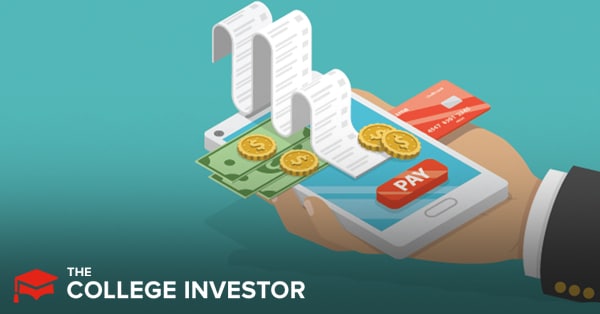How To Pay Your Student Loans Via Credit Cards


Making payments on your student loans via credit card may sound like a bad idea, and that’s because it is — at least in most cases. In fact, the U.S. Department of the Treasury prohibits student loan servicers from allowing credit card payments directly.
That said, there are other ways to make payments on your student loans using a credit card, and some of these ways allow you to earn credit card rewards along the way.
In fact, Bilt just announced that you can redeem their credit card rewards points towards your student loans.
Before you do, carefully consider the costs associated with the payment method and whether the benefit you gain is worth it.
Making payments directly to your student loan servicer using your credit card is no longer an option, but there are plenty of ways to get around that restriction. Before you consider those ways, however, it’s important to think about why it could be a bad idea.
The average credit card interest rate is 21.3%, according to the Federal Reserve, and many cards charge more. In contrast, federal student loan rates range from 6.53% to 9.085% for the 2024-2025 school year, and even private student loans may not go as high as credit card rates.
If you use a credit card to pay down a student loan balance then carry that balance on the card, it’ll cost you more.
Student loans are a form of installment credit, which means that you have a set monthly payment and repayment term. With credit cards, on the other hand, you have a minimum monthly payment but no set repayment term.
As a result, it’s possible to rack up a balance on a credit card and never pay it off. Some credit cards may offer promotions that could make it tempting to move your debt, but it’s easy to get complacent and leave a balance on your card when you don’t have a deadline.
If you have federal student loans, using a credit card to pay down some or all of your balance will relinquish your access to certain protections. That includes income-driven repayment plans, student loan forgiveness programs, forbearance and deferment options, and more.
In other words, if you move your debt over to a credit card and your financial situation changes, you’ll have fewer options to keep your payments affordable.
If you understand the dangers of using a credit card to pay off your student loans and are still interested in researching your options, here are some to consider.
Keep in mind, though, that while some may allow you to earn rewards, others won’t. And even if you are earning rewards, that doesn’t mean there’s a net benefit with the transaction.
Gift of College is a college savings gift registry that allows family members and friends to help contribute to a 529 college savings plan or assist in paying down student debt. You can use gift cards purchased from Gift of College to make payments on your student loans.
If you purchase your own gift cards, you can earn rewards on the transaction. The only catch is that you may not earn enough rewards to make up for the cost. You can purchase gift cards worth up to $200 through the registry website, but the fee for a $200 gift card is $5.95, which translates to a 2.975% fee.
There aren’t many credit cards that offer a better rewards rate consistently, and even the cards that do will give you such a marginal benefit that it may not be worth it.
Plastiq is a third-party bill payment service that allows you to use your credit card to pay various bills, including your student loan payment. To use the service, however, you’ll need to pay a 2.5% fee.
That’s cheaper than purchasing Gift of College gift cards, but still higher than what most rewards credit cards will give you.
According to a report by WalletHub, several major credit card issuers allow you to do a balance transfer from a student loan account to your credit card account. If you have a credit card with one of those issuers that’s offering a 0% APR promotion, moving your balance could give you some time to pay it down interest-free.
But in most cases, balance transfers don’t generate rewards. What’s more, most balance transfer credit cards charge a fee of 3% to 5% of the transfer amount to process the transaction, so it’s not entirely free.
And if you don’t pay the balance in full by the time the promotional period ends, you’ll be stuck with a higher interest rate on the remaining amount.
Many credit card issuers send checks in the mail that you can use to pay off other debts. Even if your card’s issuer doesn’t allow you to request a balance transfer from a student loan account directly, you may be able to use one of these checks to do the trick.
But again, using a convenience check won’t net you any rewards, and there’s likely a fee attached to the transaction. So the drawbacks are the same as doing a direct balance transfer.
Instead of using your credit card to pay your student loans for the sake of rewards, it may be a better idea to use rewards earned from your other spending to pay down your student loans.
This strategy works best if you have a cash-back credit card, as they offer more flexibility for how you can receive your rewards than travel rewards credit cards.
Keep in mind, though, that even some cash-back credit cards can restrict your redemption options. Some, for instance, may only allow you to get a statement credit, while others offer rewards in the form of a direct deposit or paper check.
Also, some cards require you to earn a minimum amount of rewards before you can cash out. If you’re considering a new card to maximize how much you can earn to pay off student loans, keep these potential limitations in mind.
Whether you’re considering using your credit card with Gift of College or Plastiq, or you want a card that allows you to rack up rewards you can use to pay down your debt, here are a few to consider.
Bilt is a membership program and credit card that allows you to earn rewards for purchases, including your rent payments. Its credit card (the Bilt World Elite Mastercard) is issued and administered by Wells Fargo Bank, N.A. If you’re a renter looking to earn rewards on your monthly rent payments, Bilt might be the solution you’ve been waiting for.
The benefit for student loan borrowers is that you can now redeem your Bilt Reward points towards your student loans.
Bilt members can now apply their points toward loan balances serviced by Nelnet, MOHELA, Sallie Mae, Aidvantage, and Navient. Every 1,000 points equals $10 towards a student loan.
If you’re looking for a credit card that offers a high enough rewards rate for Gift of College gift cards or Plastiq, the Discover it® Miles card is one option. The card normally offers 1.5 miles per dollar on every purchase you make, but Discover matches all the miles you earn during your first year, giving you a 3% rewards rate during that time.
And while it’s a travel rewards credit card, you can use your miles to get a deposit into your checking account instead of booking travel.
The card offers 3% cash-back on every purchase you make during the first year, then 2.5% cash-back after that, making it a decent choice if you want to use your credit card to pay your loans and earn rewards.
However, the card charges a $99 annual fee after the first year, which eats into the value you gain from its rewards program.
Finally, Alliant Credit Union requires you to be a member before you can apply for the card. You can apply for membership as part of your credit card application process. Once you’re approved for your credit card, then you’ll complete your Alliant membership application
If you’d rather use rewards to pay your student loans than risk racking up a balance, the Upromise® Mastercard® may be worth considering. The card offers just 1.25% cash-back on every purchase, which isn’t as impressive as the other cards we’ve covered.
But it also has a program that allows you to round up each purchase to the nearest dollar and deposit the difference into your rewards account. Then you can use those rewards to pay off student loan debt.
Again, the rewards rate isn’t as impressive, but the forced savings program could help you make bigger payments on your student loans without changing your spending habits or having you notice a big difference in your budget.
The card doesn’t charge an annual fee and a 15% cash-back bonus if you link your Upromise account to a 529 college savings plan.

Why does it feel like large companies always get the upper hand? Maybe it’s the long contracts with fine print,...

In this episode of Zephyr’s Adjusted for Risk Podcast, host Ryan Nauman engages in a deep discussion with industry expert...

Almost all retirement-aged Americans receive some amount of Social Security income. The average monthly benefit comes in at almost $2,000...